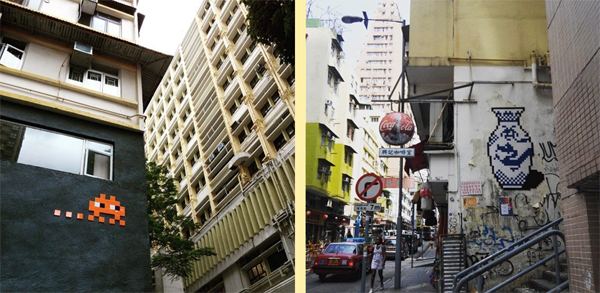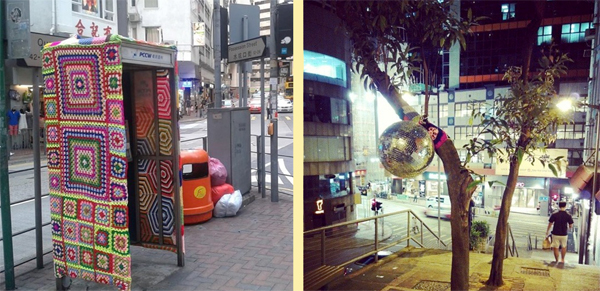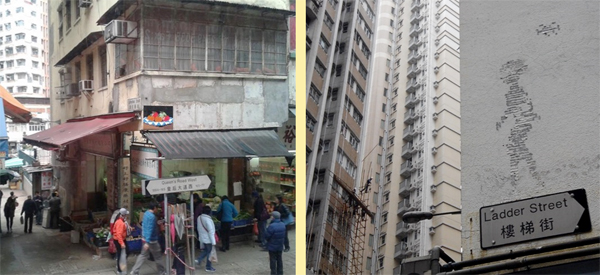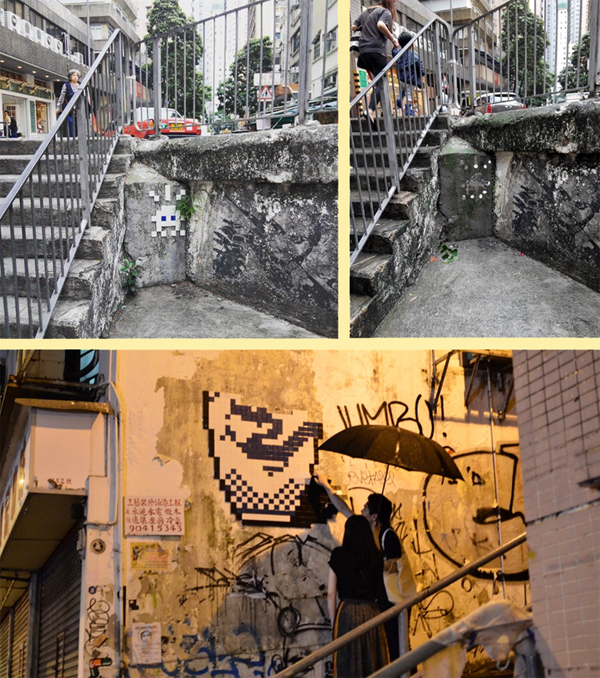On Tactics and Invaders: Street Art in Hong Kong (or Wipe Out Part Deux)
By Jennifer Gresham
I call a “tactic,” on the other hand, a calculus which cannot count on a “proper” (a spatial or institutional localization), nor thus on a borderline distinguishing the other as a visible totality. The place of a tactic belongs to the other. A tactic insinuates itself into the other’s place, fragmentarily, without taking it over in its entirety, without being able to keep it at a distance. It has at its disposal no base where it can capitalize on its advantages, prepare its expansions, and secure independence with respect to circumstances. The “proper” is a victory of space over time. On the contrary, because it does not have a place, a tactic depends on time—it is always on watch for opportunities that must be seized “on the wing.” Whatever it wins, it does not keep.
Michel de Certeau, The Practice of Everyday Life

One thing I love about my neighbourhood is that it is frequently the site of such de Certeau-esque tactics. The streets just beyond the outer edges of Soho where Sheung Wan meets Po Hing Fong are filled with traces of these unsanctioned and evanescent appropriations of urban space and symbolic acts of resistance: like the ‘yarnbombed’ phone booth outside the Wellcome on Possession Street, transformed for a day and a half by a magnificently gaudy knitted cover; or the random disco ball playfully suspended from a tree in the middle of Ladder Street, a surreal ornament that miraculously managed to survive for a couple of weeks. While on the one hand I realize that these tactical forms of street art—in and of themselves, at least—are unlikely to produce any real structural changes to existing systems of dominance, I nevertheless continue to experience them as tiny victories. Though the forms they take are usually frivolous or playful, as popular gestures of transgression they are quite beautiful. In spite of their apparent futility (or perhaps, in some instances, because of it), I find in them a source of pleasure, inspiration, and even hope. When they disappear (and they almost always do) I am often filled with a sense of sadness at their loss and irritation at those forces that simply cannot tolerate these small-scale, largely symbolic incursions—these creative but non-violent challenges to authority.

Such were my feelings last year when, one by one over the course of a few months, the clandestine mosaics erected across Hong Kong by French street artist Invader were taken down. I first became aware of this disturbing campaign to ‘wipe-out’ the anonymous artist’s works during a routine bus ride to HKU along Queen’s Road West. I had made a habit of occupying the front-row seat on the right-hand side of the bus’s upper deck, a spot that best facilitated a clear view of a mosaic installed above an independently run fruit and vegetables shop at the mouth of Sutherland Street. Like many of Invader’s local works, this one seemed to have been specifically designed to reflect and interact with its urban context, the little square tiles arranged in a rectangular grid to form an image of a bowl of fruit, a kind of parody of a traditional still-life painting. I really liked how it seemed to represent a departure from Invader’s ‘trademark’ restyling of retro videogame motifs, while at the same time retaining his signature look through the pixelating effects of his preferred medium. And then one day, just as suddenly as it appeared, it was gone, the only sign of it having been there a barely noticeable waffle-patterned imprint left by the removal of its tiles—a sort of scar that marks other sites of erasure across the city, such as the one in the shape of a woman descending the stairs that currently adorns the wall of a building where the steps of Ladder come to a halt at Queen’s Road.

I saw my pixelated bowl of fruit once again a couple of weeks ago at “Wipe Out,” an exhibition of Invader’s work held at PMQ as part of “French May.” Or, to be more accurate, I stood in front of its ‘alias’—a term used to refer to a studio-made replica or double of Invader’s street works. Though it was nice to examine it up close, it undeniably lacked some of the magic (or aura, perhaps?) of its street-copy, situated as it was in the more sterile context of the gallery space. While purchasing Invader stickers at one of the machines at the edge of the exhibition room (“STICK YOUR SPACE,” they read; “COLLECT THEM ALL!”), I surmised that surely this was a sign that the handful of new works that had begun to pop up in my neighbourhood would be more immune to the bureaucratic scruples of Hong Kong’s Roads and Highways Department than their predecessors. A week after the exhibit closed its doors, as I found myself face to face with the half-demolished remains of Invader’s newly erected mosaic of a Ming vase, I thought of de Certeau: “Whatever it wins, it does not keep.” Perhaps he was right, in more ways than one.


Our apologies, you must be logged in to post a comment.